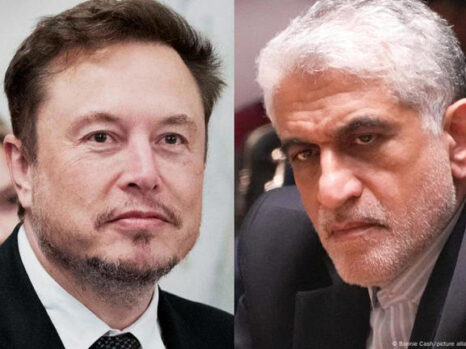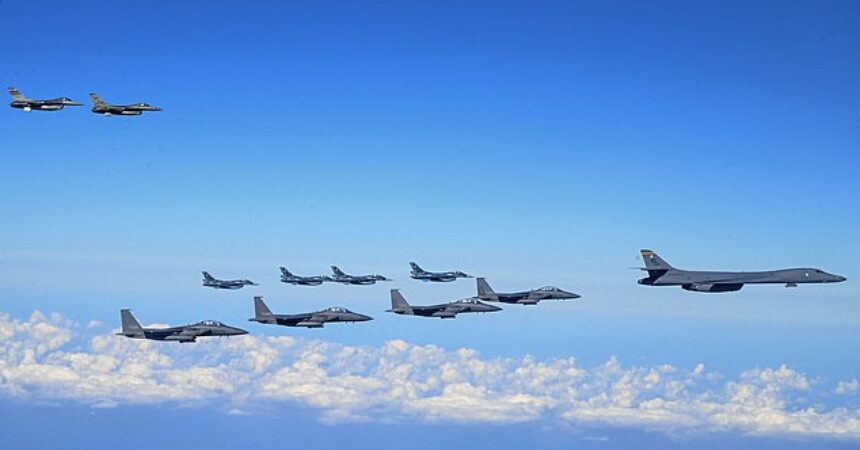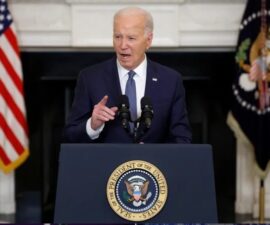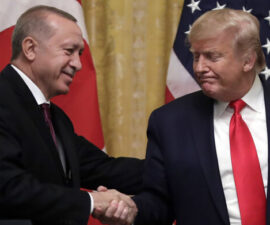The United States has launched a supersonic long-range bomber in South Korea as part of a joint air drill after Kim Jong Un bragged about having the ‘world’s strongest strategic missile’ following successful test.
The joint exercise by the US, Japan and South Korea took place three days after Pyongyang launched one of its most powerful and advanced solid-fuelled intercontinental ballistic missiles (ICBM), which experts say could reach targets in the mainland US.
The drill mobilised the US’ B-1B bomber, South Korea’s F-15K and KF-16 fighter jets, and Japan’s F-2 jets, Seoul’s military said.
‘The exercise demonstrates the commitment of the ROK-US alliance to integrated extended deterrence in response to the advancing nuclear and missile threats from North Korea,’ said South Korea’s Joint Chiefs of Staff in a press release.
During the aerial manoeuvre, South Korea and Japan’s jets escorted the US strategic bomber to a designated location south of the Korean peninsula, ‘demonstrating an overwhelming capability to swiftly and accurately strike simulated targets,’ it added.
The United States has launched a supersonic long-range bomber in South Korea as part of a joint air drill. The joint exercise by the US, Japan and South Korea took place three days after Pyongyang launched one of its most powerful and advanced missiles
North Korea’s solid-fuelled Hwasong-19 intercontinental ballistic missiles (ICBM) was tested on October 31. Experts say the missile could reach targets in the mainland US
The drill mobilised the US’ B-1B bomber, South Korea’s F-15K and KF-16 fighter jets, and Japan’s F-2 jets, Seoul’s military said
The drill mobilised the US’ B-1B bomber, South Korea’s F-15K and KF-16 fighter jets, and Japan’s F-2 jets, Seoul’s military said
The North’s latest ICBM launch is said to have flown higher and further than any previous missile, according to North Korea as well as Seoul and Tokyo’s militaries, which tracked it in real-time.
The official Korean Central News Agency hailed it as ‘the world’s strongest strategic missile,’ and leader Kim ‘expressed great satisfaction’ at the successful launch.
The launch marked the country’s longest ever ballistic missile test, with a flight-time of 87 minutes, according to South Korea, while state media in the North gloated that it set new records for its missile capabilities.
Dictator Kim Jong Un attended the launch and said the test was a warning to enemies that have been threatening the country’s security, KCNA state news agency said.
‘The test-fire is an appropriate military action that fully meets the purpose of informing the rivals, who have intentionally escalated the regional situation and posed a threat to the security of our Republic recently, of our counteraction will,’ Kim reportedly warned.
North Korea ‘would never change its line of bolstering up its nuclear forces,’ the agency said.
This picture taken on October 31, 2024 and released from North Korea’s official Korean Central News Agency (KCNA) via KNS on November 1, 2024 shows North Korean leader Kim Jong Un (R) and his daughter Ju Ae witnessing a test-fire of the new Hwasong-19 intercontinental ballistic missile (ICBM), at an undisclosed location in North Korea
This picture released by North Korea’s official Korean Central News Agency (KCNA) on October 31 shows the launch of an intercontinental ballistic missile (ICBM) during a test-fire
This handout photo taken on November 3, 2024 shows a US Air Force B-1B bomber (L), South Korean Air Force F-15K fighter jets (C), Japanese Air Self-Defense Force F-2 fighter jets (bottom L) and US Air Force F-16 fighter jets (top R) flying in formation during a joint air drill
The launch drew swift condemnation from the United States, Japan and South Korea, with Seoul warning Pyongyang could get missile technology from Russia for helping with the war in Ukraine.
The muscle-flexing comes amid a storm of international condemnation and rising alarm over what the US and others say is North Korea’s deployment of 11,000 troops to Russia – 3,000 of them close to the western frontlines with Ukraine.
A day earlier than the launch on October 31, Seoul reported signs the North may test-launch an ICBM or conduct a seventh nuclear test around the US presidential election on Tuesday, seeking to draw attention to its growing military prowess.
Shin Seung-ki, head of research on North Korea’s military at the state-run Korea Institute for Defense Analyses, said the launch was likely to test improved booster performance of an existing ICBM – possibly with the help of Russia.
‘North Korea will want to keep getting help like this, because it saves times and costs while improving performance and upgrading the stability of weapons system,’ he said.
Having come under pressure over its engagement with Russia, ‘the intention may be to show that it will not bow to pressure, that it will respond to strength with strength, and also to seek some influence on the US presidential election,’ Shin added.
The launch early on Thursday saw the missile take off on a sharply lofted trajectory from an area near the North’s capital, before it splashed down about 125 miles west of Japan’s Okushiri island, off Hokkaido.
It reached an altitude of around 4,300 miles (7,000 km) and flew a distance of 620 miles (1,000 km), the Japanese government said.
The so-called lofted trajectory of a projectile flying at a sharply raised angle is intended to test its thrust and stability over much shorter distances relative to the designed range, partly for safety and to avoid the political fallout of sending a missile far into the Pacific.
North Korea’s last ICBM, dubbed the Hwasong-18, was tested in December last year.
Fuelled by solid-propellant and fired from a road launcher, it was also launched at a sharply raised angle and flew for 73 minutes, translating to a potential range of 9,300 miles (15,000) on a normal trajectory.
That is a distance that puts anywhere in the mainland US within range














